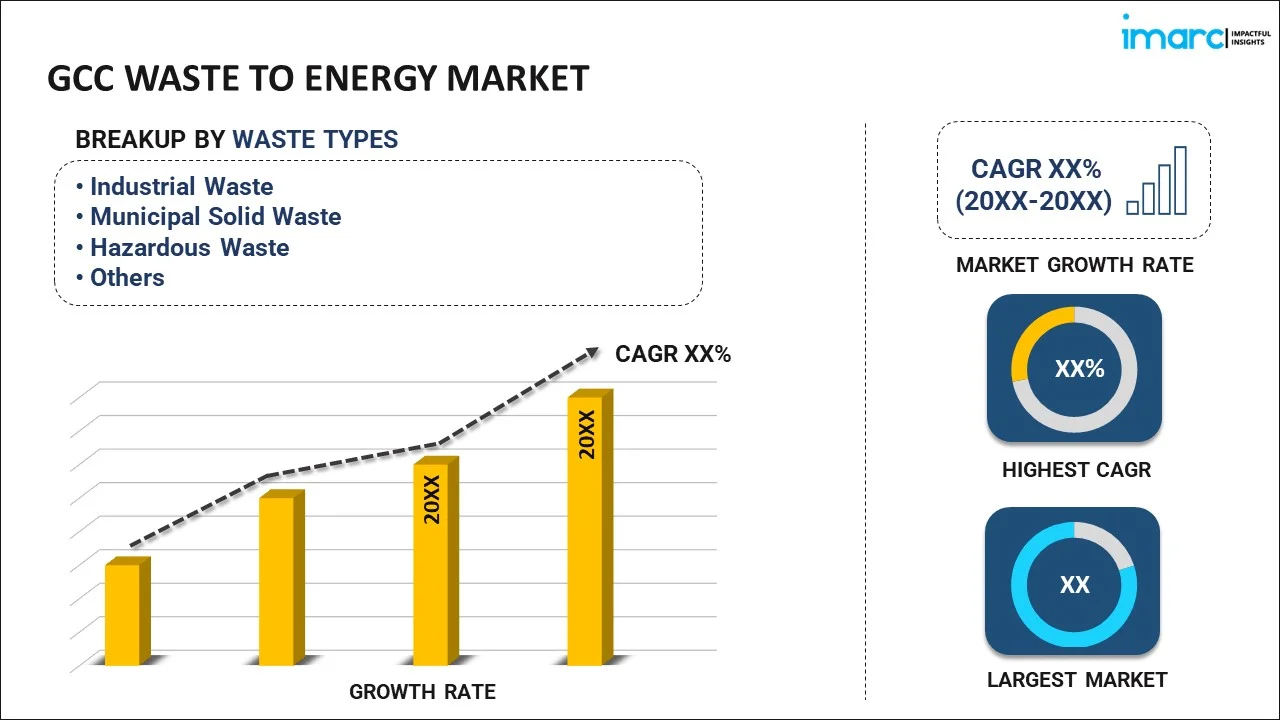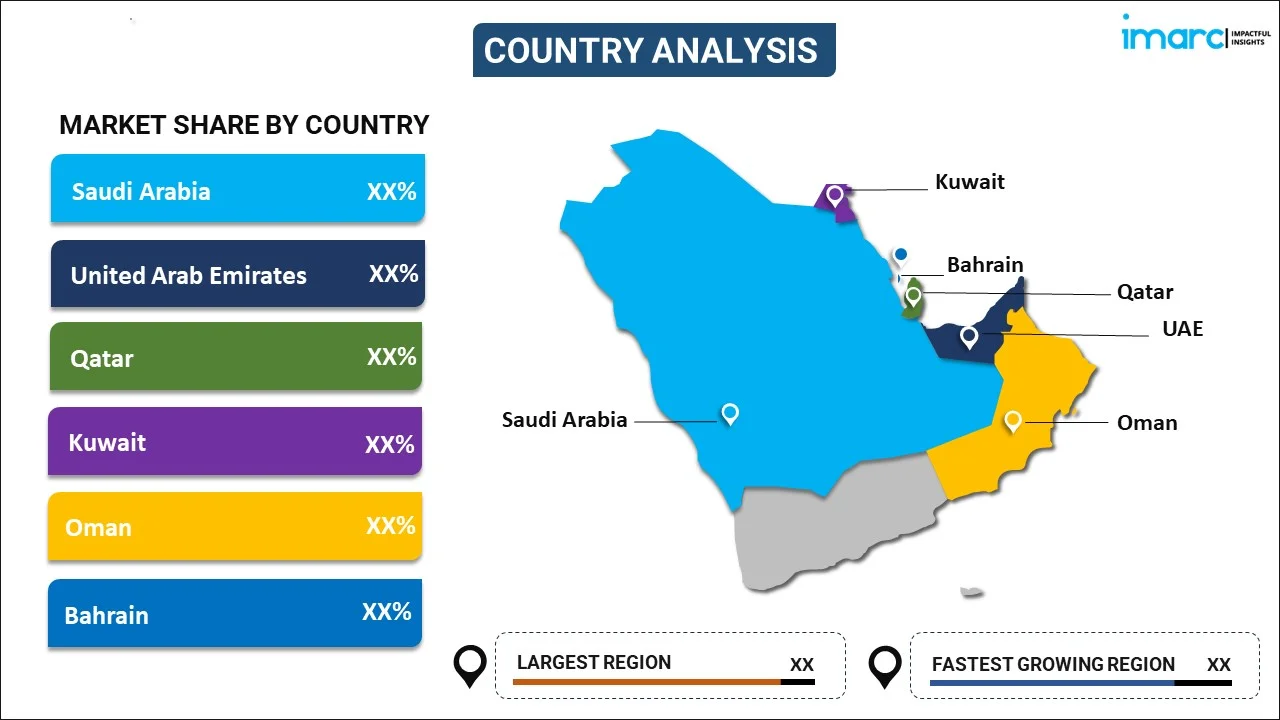
GCC Waste to Energy Market Report by Waste Type (Industrial Waste, Municipal Solid Waste, Hazardous Waste, E-waste, Plastic Waste, Bio-medical Waste), Disposal Methods (Collection, Landfills, Incineration, Recycling), Technology (Thermochemical, Biochemical), and Country 2025-2033
Market Overview:
The GCC waste to energy market size reached USD 889.3 Million in 2024. Looking forward, IMARC Group expects the market to reach USD 1,744.8 Million by 2033, exhibiting a growth rate (CAGR) of 7.8% during 2025-2033. The increasing awareness about the environmental impact of waste disposal methods, the rising government initiatives to promote renewable energy and sustainable waste management, rapid urbanization and rising population, the evolution of cleaner and more efficient WTE technologies, and growing interest from private companies and foreign investors in the GCC's WTE sector represent some of the key factors driving the market.
|
Report Attribute
|
Key Statistics
|
|---|---|
|
Base Year
|
2024
|
|
Forecast Years
|
2025-2033
|
|
Historical Years
|
2019-2024
|
|
Market Size in 2024
|
USD 889.3 Million |
|
Market Forecast in 2033
|
USD 1,744.8 Million |
| Market Growth Rate 2025-2033 | 7.8% |
Waste-to-energy (WTE) is a waste management approach that involves converting non-recyclable waste materials into energy sources like electricity, heat, or fuel. This method serves the dual purpose of reducing the volume of waste sent to landfills and generating energy, thereby contributing to sustainability and resource conservation. The primary technologies used in WTE include incineration, gasification, pyrolysis, and anaerobic digestion. In incineration, waste is burned at high temperatures, producing steam that can be used to generate electricity through turbines. Gasification and pyrolysis involve the thermal decomposition of waste in an environment with limited oxygen, producing synthetic gas or oil that can be used as fuel. Anaerobic digestion employs microorganisms to break down organic matter, such as food waste or sewage sludge, generating biogas that can be used for energy production. Waste-to-energy is particularly beneficial in regions where landfill space is limited, or where it is crucial to reduce greenhouse gas emissions from waste decomposition. Moreover, WTE technologies can recover metals and other valuable materials from waste for recycling, adding another layer of resource optimization.
GCC Waste to Energy Market Trends:
The rising awareness about the environmental impact of waste disposal methods, such as landfilling and open dumping is stimulating interest in more sustainable alternatives like WTE, which represents one of the key factors driving the growth of the market across the GCC region. The market is also driven by GCC governments initiating various policies and regulations to promote renewable energy and sustainable waste management. For instance, the UAE's Waste Management Strategy and Saudi Arabia's Vision 2030 include provisions that foster the adoption of WTE technologies, which is driving the market growth. GCC countries are looking to diversify their energy portfolios to reduce dependency on oil and gas, which is contributing to the growth of the market. WTE presents an avenue for renewable energy production, aligning with regional energy security objectives which is fueling its demand. The evolution of cleaner and more efficient WTE technologies, like advanced incineration processes and emission control systems, is making it easier for GCC nations to adopt these solutions, which is bolstering the market growth. The growing interest from private companies and foreign investors in the GCC's WTE sector is propelling the growth of the market. Public-Private Partnerships (PPPs) are increasingly becoming a preferred model for executing WTE projects. The public in the GCC is becoming more aware of the benefits of recycling and sustainable waste management, which is establishing a conducive environment for the market growth. GCC nations are signatories to various international environmental agreements and are under global scrutiny to reduce greenhouse gas emissions. WTE technologies are contributing to achieving these global commitments by mitigating the environmental impact of waste. With burgeoning urbanization and population growth, landfill availability is becoming a pressing concern for GCC nations. WTE offers an alternative waste management solution, that reduces the dependency on landfills, which is further creating a positive outlook for the market across the region.
GCC Waste to Energy Market Segmentation:
IMARC Group provides an analysis of the key trends in each segment of the GCC waste to energy market report, along with forecasts at the regional and country levels for 2025-2033. Our report has categorized the market based on waste type, disposal methods, and technology.
Waste Type Insights:

- Industrial Waste
- Municipal Solid Waste
- Hazardous Waste
- E-waste
- Plastic Waste
- Bio-medical Waste
A detailed breakup and analysis of the market based on the waste type has also been provided in the report. This includes industrial waste, municipal solid waste, hazardous waste, E-waste, plastic waste, and bio-medical waste.
Disposal Methods Insights:
- Collection
- Landfills
- Incineration
- Recycling
A detailed breakup and analysis of the market based on the disposal methods has also been provided in the report. This includes collection, landfills, incineration, and recycling.
Technology Insights:
- Thermochemical
- Biochemical
A detailed breakup and analysis of the market based on the technology has also been provided in the report. This includes thermochemical and biochemical.
Country Insights:

- Saudi Arabia
- UAE
- Qatar
- Oman
- Kuwait
- Bahrain
The report has also provided a comprehensive analysis of all the major regional markets, which include Saudi Arabia, the UAE, Qatar, Oman, Kuwait, and Bahrain.
Competitive Landscape:
The report has also provided a comprehensive analysis of the competitive landscape in the GCC waste to energy market. Competitive analysis such as market structure, key player positioning, top winning strategies, competitive dashboard, and company evaluation quadrant has been covered in the report. Also, detailed profiles of all major companies have been provided.
GCC Waste to Energy Market Report Scope:
| Report Features | Details |
|---|---|
| Base Year of the Analysis | 2024 |
| Historical Period | 2019-2024 |
| Forecast Period | 2025-2033 |
| Units | Million USD |
| Scope of the Report | Exploration of Historical and Forecast Trends, Industry Catalysts and Challenges, Segment-Wise Historical and Predictive Market Assessment:
|
| Waste Types Covered | Industrial Waste, Municipal Solid Waste, Hazardous Waste, E-waste, Plastic Waste, Bio-medical Waste |
| Disposal Methods Covered | Collection, Landfills, Incineration, Recycling |
| Technologies Covered | Thermochemical, Biochemical |
| Countries Covered | Saudi Arabia, UAE, Qatar, Oman, Kuwait, Bahrain |
| Customization Scope | 10% Free Customization |
| Post-Sale Analyst Support | 10-12 Weeks |
| Delivery Format | PDF and Excel through Email (We can also provide the editable version of the report in PPT/Word format on special request) |
Key Questions Answered in This Report:
- How has the GCC waste to energy market performed so far and how will it perform in the coming years?
- What has been the impact of COVID-19 on the GCC waste to energy market?
- What is the breakup of the GCC waste to energy market on the basis of waste type?
- What is the breakup of the GCC waste to energy market on the basis of disposal methods?
- What is the breakup of the GCC waste to energy market on the basis of technology?
- What are the various stages in the value chain of the GCC waste to energy market?
- What are the key driving factors and challenges in the GCC waste to energy market?
- What is the structure of the GCC waste to energy market and who are the key players?
- What is the degree of competition in the GCC waste to energy market?
Key Benefits for Stakeholders:
- IMARC’s report offers a comprehensive quantitative analysis of various market segments, historical and current market trends, market forecasts, and dynamics of the GCC waste to energy market from 2019-2033.
- The research study provides the latest information on the market drivers, challenges, and opportunities in the GCC waste to energy market.
- Porter's five forces analysis assist stakeholders in assessing the impact of new entrants, competitive rivalry, supplier power, buyer power, and the threat of substitution. It helps stakeholders to analyze the level of competition within the GCC waste to energy industry and its attractiveness.
- Competitive landscape allows stakeholders to understand their competitive environment and provides an insight into the current positions of key players in the market.
Need more help?
- Speak to our experienced analysts for insights on the current market scenarios.
- Include additional segments and countries to customize the report as per your requirement.
- Gain an unparalleled competitive advantage in your domain by understanding how to utilize the report and positively impacting your operations and revenue.
- For further assistance, please connect with our analysts.
 Inquire Before Buying
Inquire Before Buying
 Speak to an Analyst
Speak to an Analyst
 Request Brochure
Request Brochure
 Request Customization
Request Customization




.webp)




.webp)












